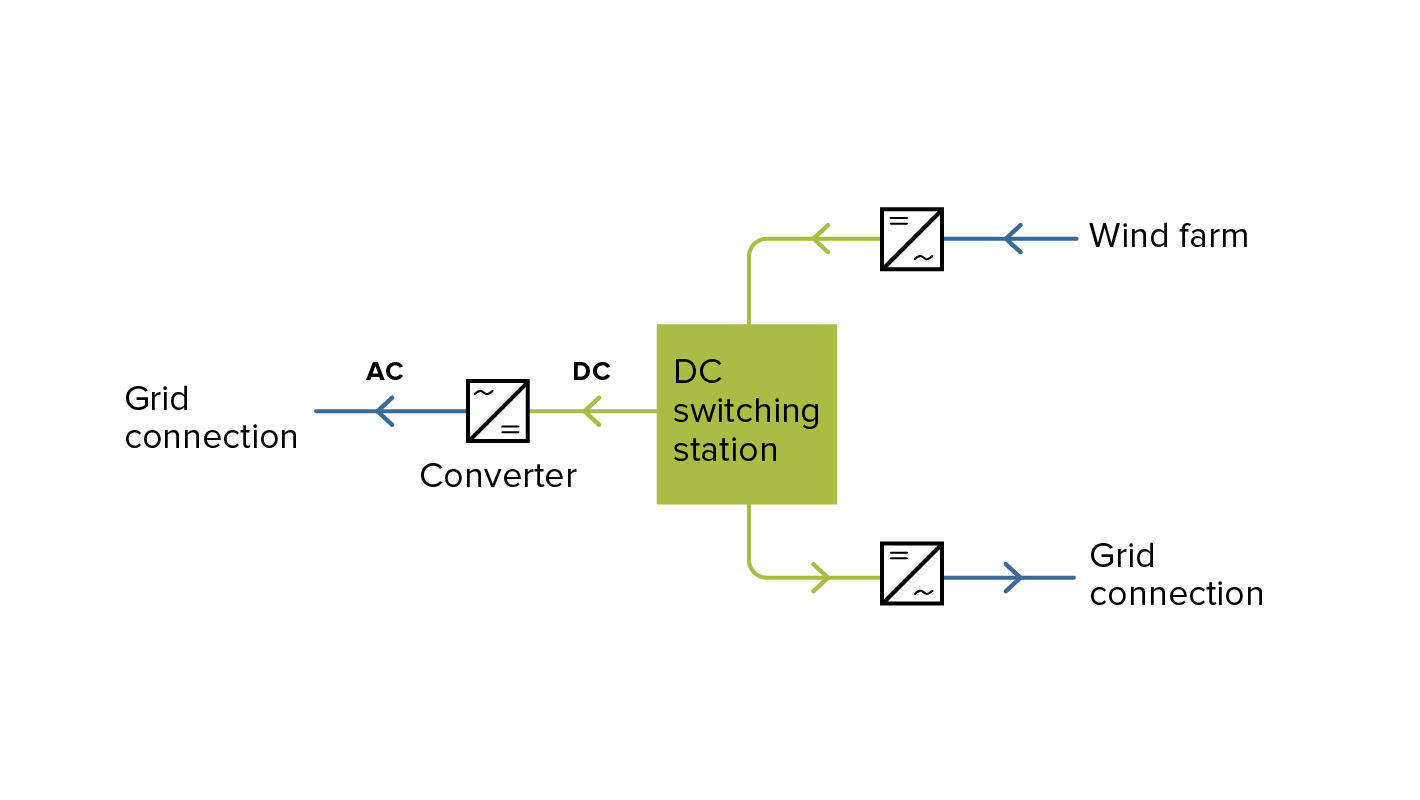Developing the net zero grid

Project Overview

As the UK turns increasingly to wind energy to boost its energy security and sustainability, new transmission infrastructure must be built. Around the coast, work is under way to install several thousand kilometres of high voltage direct current (HVDC) links capable of carrying up to 2GW of renewable electricity from remote, windy locations to centres of high demand.
The pace of development is rapid as transmission network operators strive towards the UK government’s goal of supplying 50GW of energy from wind power by 2030.
AC/DC
Wind turbines, like coal, gas and nuclear powered turbines, produce alternating current (AC) electricity – and the UK’s entire electrical system is designed to run on AC power. However, over longer distances and at high voltages, AC transmission suffers from substantial electrical losses.

For transmission over large distances, alternating current from wind turbines needs to be converted to direct current (DC), and then back to AC again for distribution and use. This requires the construction of converter stations.
Separating out the civils
Converters are designed, manufactured and installed by equipment suppliers. And until now, it has been common practice for these suppliers to design and construct not only the specialist buildings to house the converters but also the associated earthworks, site drainage and access works, communications and domestic power supply, environmental enhancements and more.
However, there are only a small number of original equipment manufacturers (OEMs) worldwide. Transmission network operators are recognising that the volume of HVDC projects to be delivered could stretch the supply chain as a whole, and in particular the converter OEMs.
To meet the challenge, one of the UK’s three network operators, Scottish & Southern Electricity Networks (SSEN), is choosing to disaggregate civil engineering from equipment supply, enabling OEMs and civils designers to focus on their separate areas of expertise.
As part of this approach, SSEN awarded us an eight-year framework agreement to develop an employer’s civil design (ECD) for future converter stations.
Designing converter stations
Under the framework agreement to develop an employer’s civil design for future converter stations, our engineering design support includes:
- Geotechnical and foundations to support HVDC equipment and comply with strict manufacturing and operational tolerances
- Structures and cladding, which must withstand battering by the fierce winter storms that sweep Scotland
- Ventilation, airtightness and climate control to manage humidity and temperature
- Fire containment and suppression
- Containing radio frequency interference from equipment using Faraday cages within equipment halls
- Magnetic clearances and the use of non-ferrous construction and fit-out materials
- Electrical clearance, to prevent electricity from jumping or arcing to any part of the building
- Routing of a significant volume of ducted services and cables around the site and buildings.
Specialist skillset
We have been among the pioneers in HVDC transmission, working on up to 30 projects over the last two decades, including the trailblazing ElecLink 1GW interconnector that runs through the Channel Tunnel between France and England. This interconnector allows two-way flows, contributing to energy efficiency and security for both countries.
Caroline Pye, development manager for Mott MacDonald’s energy networks portfolio, says: “Our team of in-house HVDC specialists and civil engineering experts has more than a decade of experience in delivering these complex, multidisciplinary projects. It’s a combined skillset that creates substantial opportunity to add value.”
The Shetland Link
Our ECD role builds on our HVDC track record with SSEN, which includes technical support, engineering and interface management for Scotland’s first HVDC link from Caithness to Moray, completed in 2019, and the subsequent Shetland Link, due for completion in 2024.

The Caithness-Moray Link is the first three-way HVDC connection in Europe using voltage source converters – a power electronics technology that has only recently become capable of handling HVDC.
We were appointed in 2018 to develop the design of the project’s converter station at Kergord, Shetland, and the DC switching station at Noss Head. We then worked with contractor Bam Nuttall to provide detailed design for the following phases of the project. That included providing expertise in building information modelling (BIM), which enabled a step change in coordination between building design and OEM equipment, as well as information sharing and documentation control.
The Caithness-Moray Link is Europe’s first three-way HVDC connection using voltage source converters
Scaling up
The Caithness-Moray and Shetland Links use the industry standard HVDC transmission voltage of +/-320kV. However, it is expected that recent developments in cable and converter technology will result in the adoption of a higher transmission voltage of +/-525kV. This allows for higher power transfers of up to 2GW.
Under the ECD framework and working with the wider supply chain, we will optimise the converter station design for construction, employing offsite and modular construction where possible to enable faster, less resource intensive delivery.
The standardised building and site design will substantially reduce front-end engineering and detailed design requirements, as well as unlocking construction efficiencies – all reducing demand for resources in a tightly constrained market.


We developed the design of the converter station at Kergord in Shetland (Credit: SSEN)
We developed the design of the converter station at Kergord in Shetland (Credit: SSEN)
Circuit breaker challenge
Since 2022 we have been providing technical support to SSEN on a research project of major importance for the future development of HVDC transmission circuit breakers.
AC systems use high speed switches called circuit breakers to interrupt the high currents that flow when an electrical fault occurs. Circuit breakers enable interconnection across the AC network: the faulting element can be cut out, leaving most of the network in service.
However, affordable circuit breakers are currently not available on the market for HVDC systems. The most effective solution at present is to convert DC back to AC. Developing affordable circuit breaker concepts in consultation with key manufacturers will enable greater flexibility in grid operation and reduce the cost of delivering the HVDC grid overall.



